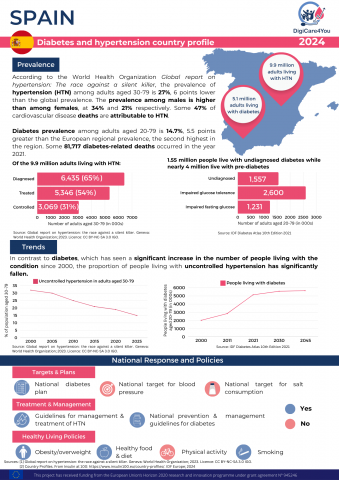Across the world, 537 million people were living with diabetes in 2021, of whom 61 million in Europe, and this figure is anticipated to increase to 643 by 2030 (67 million in Europe).
An estimated 1.28 billion adults aged 30-79 years worldwide live with hypertension (HTN). HTN is also approximately twice as prevalent in people living with diabetes as in the general population.
What is the status of diabetes and HTN in the DigiCare4You pilot countries – Albania, Bulgaria, Greece and Spain? In Spain, there are 5.1 million adults living with diabetes and 9.9 million adults living with HTN. The prevalence of diabetes is higher than the European regional prevalence while the prevalence of HTN is lower than the global prevalence.
Despite 65% of adults living with HTN being diagnosed, only 31% have their condition under control and approximately 1.55 million people are currently living with undiagnosed diabetes. Uncontrolled HTN and undiagnosed diabetes are significant issues as they can result in life threatening complications.
National policies are essential in helping to prevent the development of conditions such as T2D and HTN as well as improve the overall management. Spain has a national diabetes plan as well as treatment and management guidelines for both HTN and diabetes. Spain, however, does not have a national target for blood pressure or salt consumption.
Diabetes and HTN country profiles that look at the prevalence, trends and national responses and policies have been developed for each DigiCare4You country. Read the profile for Spain here.

